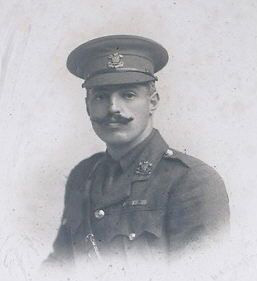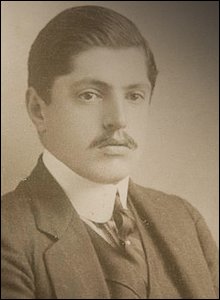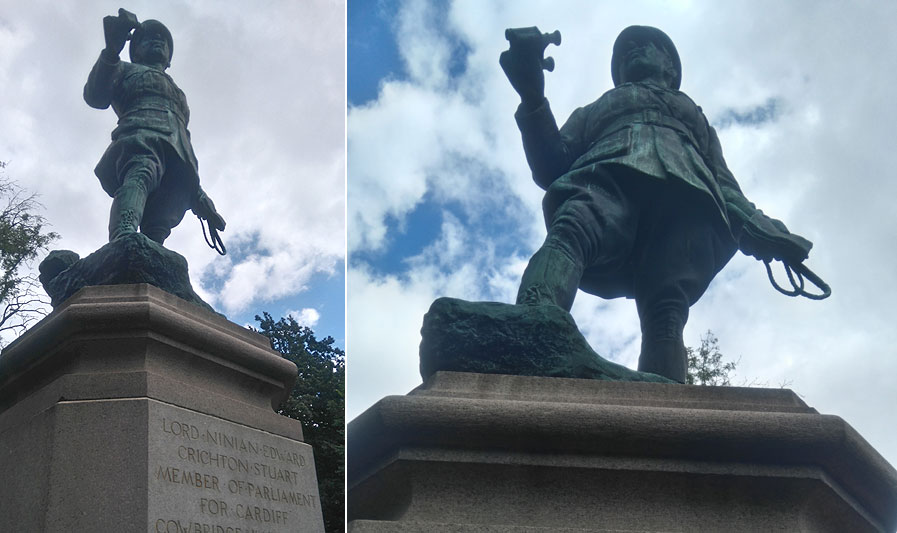

Lord Ninian and 'courage bordering on recklessness'


Lord Ninian was killed in October 1915 as he stood rallying his men
Lord Ninian Edward Crichton Stuart is the highest ranking officer remembered
on the Grangetown war memorial. He was the local MP and is fittingly remembered
in a park, which the Bute family, along with the Plymouth family, were responsible
for donating land for at the end of the 19th century. His grand-daughter MARIETTA
CRICHTON STUART has been researching his life - including his involvement in
local politics in Grangetown - and tells his story.
Lord Ninian Edward Crichton Stuart was born on 15 May 1883 at Dumfries House,
Ayrshire in Scotland, the second son John Patrick Crichton-Stuart, the third
Marquess of Bute, and his wife Gwendolen.
The family had several homes - living in London, Scotland and in Cardiff Castle.
Before going to Harrow School, Ninian was educated at home and learnt Welsh.
He later went to Russia to study the language and in October 1901 went up to
Christ Church Oxford . His father had died in 1900 and, at the age of 21, Ninian
inherited property at Falkland in Scotland. In 1905 he joined the 1st Battalion
Scots Guards as a Second Lieutenant and the following year married Ismay Preston.
Having decided on a career in politics, he resigned from the Army. In September
1907 he was adopted as the Conservative and Unionist Party Parliamentary candidate
for the constituency of Cardiff, Llantrisant and Cowbridge.
He campaigned hard in the constituency for three years attending political
meetings in Grangetown at the gasworks, the Conservative club and at St Patrick's
School. In 1910 there were two General Elections. In January he lost to the
Liberal candidate by 1,955 votes, but in December won by 299 votes. Although
active as a constituency MP, Ninian was only an occasional speaker in the Commons.
He had stood as a guarantor for £90 to Cardiff City Football Club and their
ground was subsequently named after him. He and his wife had two daughters and
two sons, their eldest son (also called Ninian) died in 1910 aged three and
their second son, Michael, was born in March 1915 six months before Ninian was
killed. In March 1911 Ninian was appointed the commanding officer of the 6th
(Glamorgan), Welch Regiment which mainly recruited from Swansea and Neath.
At the outbreak of war the entire Battalion volunteered for foreign service.
On 28th October the 6th Welch departed Swansea Drill Hall for "destination unknown",
30 officers, 812 men of all ranks and 586 horses. In addressing the troops Ninian
said "The greatest honour a man can receive is that he has been provided
with a chance to give, if need be, the greatest that he has, which is his life,
for his country, I do not doubt every man on this parade will give it and give
it as willingly as I mean to give it myself." Between November 1914 and
May 1915 the battalion was based in Boulogne and later St Omer working on lines
of communication. Throughout this period, they were all anxious to get to the
trenches for "real fighting". In June 1915 the Battalion went to Wizernes for
a month's training. In July it joined the 84th Brigade in the 28th Division,
based at Locre and was in trenches at Lindenhoek, east of Kemmel, not far from
Ieper. On 21 September 1915 the battalion left Locre and by 30 September was
at Sailly Labourse in the Reserves for the Battle of Loos.
On Saturday 1st October the 6th Welch went into the trenches near the German
held fortification the Hohenzollern Redoubt. Later that day, together with the
1st Welch, it was part of an attack on nearby Little Willie trench. Part of
the trench was captured, but the Germans counter-attacked. Ammunition was short
and the 6th started digging a sap to connect Little Willie with the British
forward trench. The following day, the sap was still three to five yards short,
but ammunition was running out and the decision was made to evacuate the 1st
and 6th Welch from Little Willie. Whilst supervising this, he stood on the fire
step to rally the men and was shot dead. Twenty five men of the battalion were
killed in the two days. The Western Weekly Mail reported: "Lord Ninian
was a brave, heroic officer, with courage which bordered on recklessness. All
along he had been encouraging his men." His body was taken to the Catholic church
at Sailly Labourse. A zinc lined coffin was obtained which would be suitable
if the body was to be returned to Britain after the war. The coffin was taken
to the nearby town of Bethune where it was put into the vault by the gates of
the cemetery. In the late spring of 1918, the vault was damaged during a German
bombardment and the coffin was buried in the cemetery. Initially there was a
wooden IWGC cross on the grave and the family erected a stone cross. Now there
is just the CWGC cross with his details and "They may rest from their labours
for their works will follow them". Ninian was the fifth MP to be killed in the
Great War and is commemorated with a statue in Gorsedd Gardens, central Cardiff.
Marietta Crichton Stuart,
August 2014

Marietta reading out her grandfather's name, with other families at the memorial event in August 2014
The statue in Cathays Park near the National Museum.